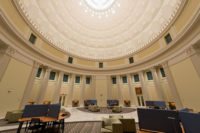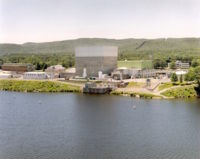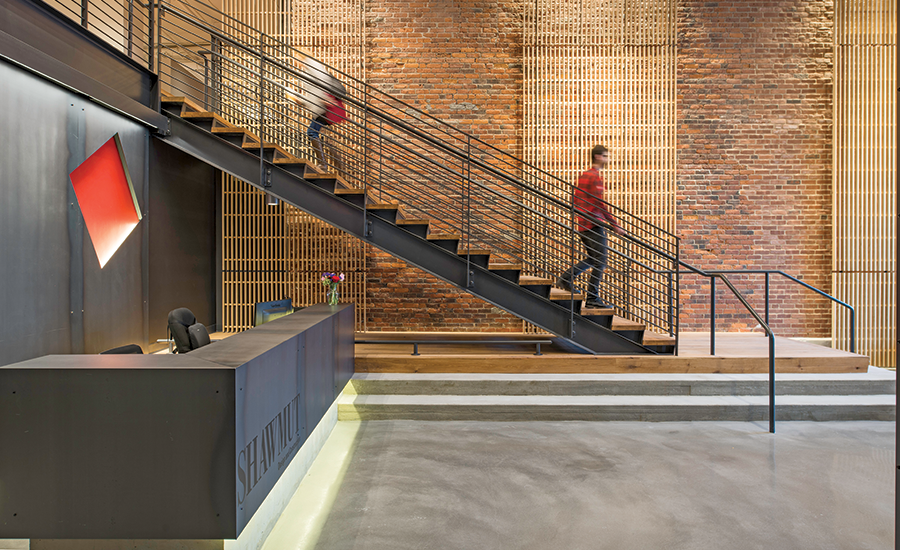Collaboration Drives Shawmut Forward
Boston-based Shawmut Design and Construction named ENR New England Contractor of the Year

Shawmut recently renovated its headquarters to be a hub of collaboration, communication and camaraderie.
PHOTO COURTESY OF SHAWMUT DESIGN AND CONSTRUCTION

Shawmut’s $265-million retail division builds complex and luxurious projects for the likes of Louis Vuitton, Cartier and Apple. The group recently completed the 12,400-sq-ft, multilevel Uniqlo Faneuil Hall in Boston. The specialty store for the Japanese retailer features mannequins that appear to be floating inside a glass cylinder. Fabricated off site, the Shawmut team created additional support to hold the weight of the materials.
PHOTO COURTESY OF SHAWMUT DESIGN AND CONSTRUCTION

Known for historic preservation work, Shawmut performed one of the largest cast-stone replacements in the country on Boston College’s St. Mary’s Hall. Shawmut removed or replaced more than 15,000 elements, including sculptures.
PHOTO COURTESY OF SHAWMUT DESIGN AND CONSTRUCTION

Shawmut had its first $100-million building last year when it built the Bruce C. Bolling Municipal Building in Boston’s Dudley Square. The 215,000-sq-ft complex was named ENR New England’s Project of the Year in 2015.
PHOTO COURTESY OF SHAWMUT DESIGN AND CONSTRUCTION




The vibe at Shawmut Design and Construction’s newly renovated Boston headquarters is more like a well-funded start-up than a 34-year-old general contracting firm. Indie rock music hums in the lobby/café with its polished concrete floors, exposed brick and a steel-beam sculpture strung from the 20-ft-high ceiling. Employees gather at rustic white oak high-top tables near a billiards table and a 22-ft-long bar featuring a backsplash with race-car red tiles laid in a brick pattern.
Casually dressed employees wearing earbuds huddle over laptops while talking on iPhones. Workstations in an open floor plan have desks that rise to the standing position at the push of a button. Huddle spaces with comfy red chairs and flat-screen TVs are perfect for small groups. Meanwhile, telephone booths and the “Focus Forest” allow for privacy and concentrated work.
Executives sit in a row of offices with floor-to-ceiling glass walls; CEO Les Hiscoe’s 120-sq-ft corner digs overlook Boston’s trendy, yet historic South End. A few doors down, the director of construction operations for the New England group contemplates the square footage of his own office. “We can’t even count ceiling tiles can we?” Tim Hurdelbrink says while glancing at exposed ductwork. He adds, “Leadership is available and accessible, and it’s all about being with your teams; don’t hide behind a closed door.”
This upbeat, transparent and dynamic space reflects the collaborative approach Shawmut brings to each of the approximately 500 projects it undertakes annually.
The 100% employee-owned company ranked eighth in Boston Business Journal’s 2016 Best Places to Work survey. It has 1,100 workers nationwide, including 555 across New England in four offices. Shawmut also has offices in New York, Los Angeles, Los Vegas and Miami. A 0.72 experience modification rate is augmented by the fact that Shawmut has gone seven years without a fatality. Shawmut also works with 26 major philanthropic partners and has fielded a team in the Pan-Mass Challenge for nine years. Shawmut has raised more than $752,000 for cancer research in the 190-mile charity road race from Sturbridge, Mass., to Provincetown.
The firm ranks third in ENR New England’s inaugural Top Contractor rankings with $616.39 million in regional revenue. This year the firm jumped to 59 on ENR’s national list of Top 400 Contractors, up from 63 the previous year, after its revenue rose 22.6% in 2015 to $1.2 billion.
For all these reasons, ENR New England has selected Shawmut as the first-ever Contractor of the Year for the region—which covers Connecticut, Maine, Massachusetts, New Hampshire, Rhode Island and Vermont. Known for complex and fast-tracked projects as well as historic preservation, Shawmut has an active institutional portfolio and commercial retail portfolio, which includes the Uniqlo store in Boston’s Faneuil Hall.
Hiscoe, 50, spent 17 years at Shawmut before becoming CEO in July 2015 and says Shawmut delivers more than just the basic on time and on budget building. “We talk a lot about the experience, about the ride,” he says. “On time, on budget, good quality, with great experiences, having some fun, no surprises, a lot of proactive communication and a lot of camaraderie is the ride we want to give customers.”
Jim Ansara founded Shawmut in 1982 after dropping out of college not once, but twice. Working out of his truck, Ansara carved a niche in restaurant construction and eventually moved into New England’s vibrant academic sector. He sold 70% of the company to the employees in the early 2000s and eventually relinquished the remainder of his stock when he was confident the new leadership could maintain the company’s culture.
Today, the firm is run by a 12-person executive committee. A third of all profits go into the employee stock ownership plan (ESOP), while another third goes toward bonuses and a final third is reinvested back into the company. “The long-term success of the company ultimately ends up back in your pocket,” Hurdelbrink says.
Much of Shawmut’s recent success can be attributed to its first $100-million building. Named ENR New England’s Project of the Year in 2015, the Bruce C. Bolling Municipal Building is located in Boston’s Dudley Square. The 215,000-sq-ft headquarters of the Boston Public Schools incorporates the historic facades of three buildings. It was the Boston’s Public Facilities Dept.’s first use of the construction manager at-risk delivery model, and it achieved some of the highest percentages ever for hiring local residents and minorities in the city’s history.
For Shawmut, the structural complexity of keeping the existing facade standing next to an operational bus terminal in a dense neighborhood “showed what we are capable of,” Hiscoe says. “It was a great project for us as far as putting us on the map for a bigger project.”
Another recent breakthrough came in Boston’s flourishing health care market. After hiring Dave Surette to be director of health care and life science in 2013, Shawmut earned $66.56 million in health care revenue in 2015. That included significant work at Boston Medical Center and some work in the Longwood Medical area. Now health care and life sciences accounts for 12% of Shawmut’s business, with new facilities for Hologic, Eli Lilly and Proctor and Gamble currently in the works.
The academic sector still remains Shawmut’s bread and butter, accounting for 56% of the firm’s business. Two recent academic jobs called on Shawmut’s in-house historical preservationist, Carl Jay. The restoration of MIT’s iconic Great Dome required Shawmut to replicate the early 1900s structure by using new glass blocks that match the original glass design and color of the 75-ft rotunda with an intricate 27-ft skylight. At Boston College’s St. Mary’s Hall, Shawmut performed one of the largest cast-stone replacements in the country. More than 15,000 cast-stone elements, including sculptures and custom components, were removed and replaced.
In 2012, the academic group finished Shawmut’s first net-zero building at Choate Rosemary Hall in Connecticut. The Kohler Environmental Center is the first teaching, research and residential environmental center in U.S. secondary education. Shawmut’s regional director for western Massachusetts Michael Kearns says the Kohler Center positions Shawmut well to win future sustainable building projects, including the recently awarded contract for the 40,000-sq-ft science addition at the net-zero campus of Mount Wachusett Community College in Gardner, Mass.
Shawmut has done $325 million in work for Brown University over 16 years and is currently building the $88-million engineering building under an integrated project delivery contract. More frequently used in health care projects than higher-education jobs, the risk-and-reward-sharing model uses one contract among all the entities involved in the project.
Not for the faint of heart, IPD projects require a supreme commitment to collaboration. But Stephen Maiorisi, Brown’s vice president of facility management, says Shawmut’s collective approach gave the university the confidence to enter into a contract with 20 entities.
“They realize for the project to be successful everybody on the team needs to be successful,” he says. “Unfortunately, some contractors like to put up walls and blame the architects rather than solve the problem … so there’s change orders that benefit them. That doesn’t happen with Shawmut.”
Perry Ashenfelter, the engineering building’s project manager, interned for Shawmut before graduating from Brown in 2013. She says one reason she joined Shawmut full time was because of the firm’s supportive environment. For example, when she wanted to learn about 3D coordination, her superiors nurtured her curiosity, she says. Now she’s the “tech guru” on her team. “When you feel really excited about something and then have that supported,” she says, “it really makes people happy to be at a company that promotes that.”
Many of Shawmut’s recruits undergo a 36-month training program that includes rotations in project management, site supervision and estimating. More than 20% of Shawmut employees are currently in or have graduated from the program. Last year’s class of 32 graduates was selected from 2,500 resumes.
With no acquisitions to date, recruiting is key to becoming what Hiscoe calls a “world-class talent organization.” And renovating their offices to be a hub of collaboration, communication and camaraderie plays a large role in that effort. “We really believe that if you don’t feel great at work it’s going to show through to your customer,” Hiscoe says, “and you’re not going to deliver the best construction experience.”









